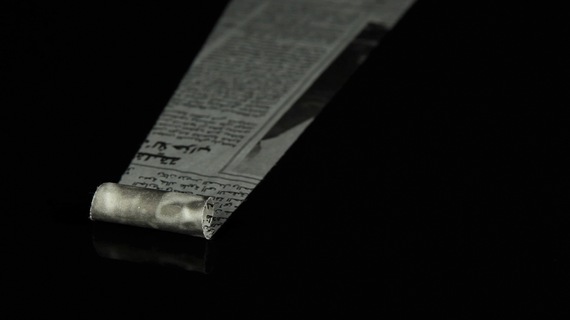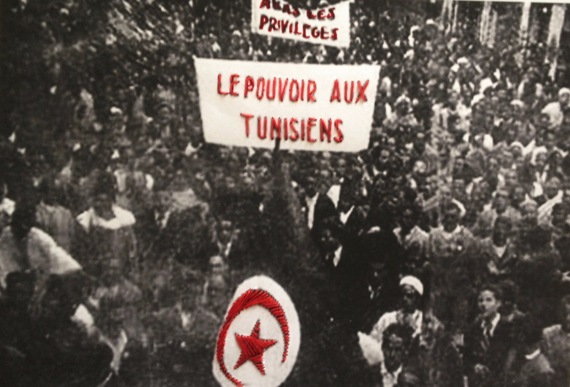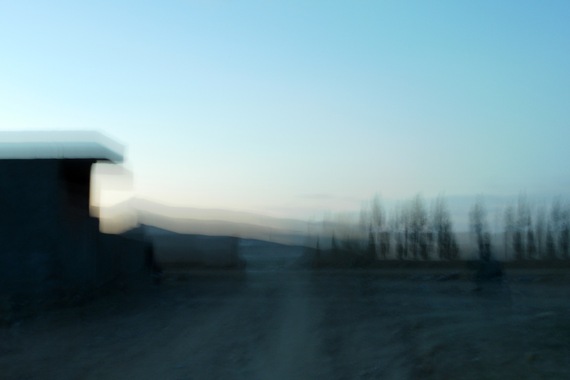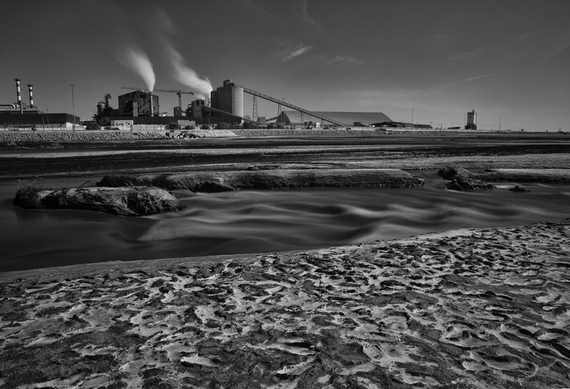Héla Ammar "weaves time" via the red thread she has used to stitch the poster-sized historic images of her country under the thumb of brutal French colonialism, hopeful liberty where women can toss aside the scarves as they wish, and the fragmentary glimpses of a possible future where neither the distortions of a false Islamist demonism nor the dictatorial models of neighboring Arab police states will triumph.
Fakhri el Ghezal tracks through photography the repeated absences and missing continuities of political leaders ripped away posters and billboards during the last half century since Tunisia freed itself from the French heel. Souad Mani traces the soft transitions of morning light in a series shifting time-lapse images that are as poetically seductive as they are jarringly disturbing. Sun and fog open light on magnificent and revolting landscapes, not unlike Monet's cathedrals of the 19th century.
© Courtesy of the artist and Galerie Les Filles du Calvaire, Paris
Ismail Bahri rolls, unrolls and rerolls passing news notices in a video that seems to capture the fragment memories that might have captured any waking or dreaming Tunisian (or Frenchman or Angeleno) during the last decades of war, promise and celebration that anyone over thirty who dares to see, read or feel about the fragmentary signals that make up our daily consciousness.
These and several other little-known Tunisian image artists have been brought together in the always remarkable MuCEM museum in Marseille--dedicated to demonstrating that the arts and cultures of the Mediterranean are as complex and subtle as the currents that made up this ancient saucer of Occidental Civilization and contemporary anxiety. Titled Traces--Fragments of a Contemporary Tunisia, this exhibit--up at the MuCEM through the end of September--marries poetry to light to desperation in a single darkened gallery and offers as good a primer on what Tunisia has been and is becoming beyond the recent headlines that portray it as a slaughter house of rich vacationers.
The images require time and reflection, for they are all reflections on what it means to be Tunisian--a relatively small country of 11.2 million where about half are under age 35. Unlike its neighbors, Algeria and Libya, it has so far avoided bloody revolution even as it escape France's harsh colonial rule relatively peacefully. Its secular founding leader, Habib Bourguiba, repeatedly imprisoned by the French set the country on a social democratic future and established its largely secular system of laws where, until recently, middle class women rejected the Islamic veil. At the same time, extractive mining and oil and gas factories, often controlled by foreigners have stalled the Tunisian economy just as its population has exploded, resulting in 40 percent youth unemployment.
All of these realities and memories burble through the exhibit, including heretofore blocked images of uncontrolled toxic pollution from a half dozen phosphate mines whose radioactive waste poisons the land and flow directly into the Mediterranean sea--even as in its refined form it nourishes the grain fields of France, Germany, Britain and Poland. Phosphate remains the country's primary export just as its secular profile has led it to promote coastal tourism.
The images jointly selected by French and Tunisian curators from an original selection of 40 artists somehow avoid polemics all the while opening windows on a culture that vibrates between optimism and anxiety over is future. These "traces" are prisms of the life rhythms of Tunisia today, said MuCEM co-curator Thiery Fabre. "These are small images of Tunisia where democracy exists. There is a Tunisia today that is very contemporary, a young generation who are engaged on a global scale with global ideas who create contemporary forms. It's a country that is magisterially in political transition, with a young generation who hope to make another future."
But as Héla Ammar says of her own embroidered silk linking of historic photographs, history tends to occur in loops, moments of creation and destruction, weaving and unweaving, be it of democratic participation or women's independence: "I'm concerned with memory as well as the body: the act of undoing, of deconstructing what has been done or built with great effort and sacrifice is never trivial, in the same way it is not the reconstruction of what has been done."
Reflecting on the growing threats to Tunisian secular democracy co-curator Thiery Fabre added, "It's true that the attack on the Bardo art museum and on the beach were terrible, but you cannot conflate that with contemporary Tunisia...any more than you can confuse the murder of those black people in their church in Charleston with contemporary young Americans."



